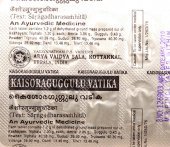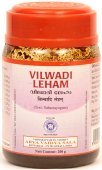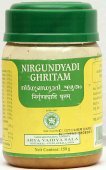Tryushana, Tryuṣaṇa: 8 definitions
Introduction:
Tryushana means something in Hinduism, Sanskrit. If you want to know the exact meaning, history, etymology or English translation of this term then check out the descriptions on this page. Add your comment or reference to a book if you want to contribute to this summary article.
The Sanskrit term Tryuṣaṇa can be transliterated into English as Tryusana or Tryushana, using the IAST transliteration scheme (?).
In Hinduism
Ayurveda (science of life)
Cikitsa (natural therapy and treatment for medical conditions)
Source: Ancient Science of Life: Botanical identification of plants described in Mādhava CikitsāTryuṣaṇa (त्र्युषण) refers to a group of three medicinal plants used in the treatment of atisāra (diarrhoea), according to the 7th century Mādhavacikitsā chapter 2. Atisāra refers to a condition where there are three or more loose or liquid stools (bowel movements) per day or more stool than normal. The second chapter of the Mādhavacikitsā explains several preparations [including Tryuṣaṇa] through 60 Sanskrit verses about treating this problem.
The three species of medicinal plants included under tryuṣaṇa are:
- Pippalī (or Kaṇā, Kṛṣṇa): Piper longum L.
- Marīca: Piper nigrum L.
- Śuṇṭhī, (or Viśvabheṣaja, Viśva, Tryuṣaṇa, Nāgara, Ārdraka): Zingiber officinale Roxb.
Toxicology (Study and Treatment of poison)
Source: Shodhganga: Kasyapa Samhita—Text on Visha ChikitsaTryūṣaṇa (त्र्यूषण) (or Trikaṭu, Kaṭutraya) refers to an herbal ingredient which is included in a (snake) poison antidote recipe, according to the Kāśyapa Saṃhitā: an ancient Sanskrit text from the Pāñcarātra tradition dealing with both Tantra and Viṣacikitsā—an important topic from Āyurveda which deals with the study of Toxicology (Viṣavidyā or Sarpavidyā).—In the Añjana or Collyrium segment of the eighth Adhyāya, Kāśyapa prescribes eight types of permutation and combination of herbs that effectively arrest poison. According to Kāśyapasaṃhitā (verse VIII.37)—“A combination of Śiriṣa, Elā, Niśā, Lac, Māṃsī, Yaṣṭhi, Mustard, salt, Trivṛt, Yaṣṭhi, Viśālā, Trikaṭu (tryūṣaṇa), two varieties of Niśā, with Madhu and Māñjiṣṭhā placed in the cow’s horn form a formidable drug to eliminate venom”.

Āyurveda (आयुर्वेद, ayurveda) is a branch of Indian science dealing with medicine, herbalism, taxology, anatomy, surgery, alchemy and related topics. Traditional practice of Āyurveda in ancient India dates back to at least the first millenium BC. Literature is commonly written in Sanskrit using various poetic metres.
Languages of India and abroad
Sanskrit dictionary
Source: Cologne Digital Sanskrit Dictionaries: Shabda-Sagara Sanskrit-English DictionaryTryuṣaṇa (त्र्युषण).—n.
(-ṇaṃ) The three spices collectively, or black pepper, long pepper, and dry ginger. E. tri three, and uṣaṇa a spice or pungent substance; also with ūṣaṇa the same, tryūṣaṇa, n. (-ṇaṃ) .
Source: Cologne Digital Sanskrit Dictionaries: Monier-Williams Sanskrit-English Dictionary1) Tryuṣaṇa (त्र्युषण):—[=try-uṣaṇa] [from try] n. =-ūṣ, [cf. Lexicographers, esp. such as amarasiṃha, halāyudha, hemacandra, etc.]
2) Tryūṣaṇa (त्र्यूषण):—[=try-ūṣaṇa] [from try] n. = tri-kaṭu, [Suśruta]
Source: Cologne Digital Sanskrit Dictionaries: Yates Sanskrit-English DictionaryTryuṣaṇa (त्र्युषण):—(ṇaṃ) 1. n. Black and long-pepper and dry ginger united.
[Sanskrit to German]
Sanskrit, also spelled संस्कृतम् (saṃskṛtam), is an ancient language of India commonly seen as the grandmother of the Indo-European language family (even English!). Closely allied with Prakrit and Pali, Sanskrit is more exhaustive in both grammar and terms and has the most extensive collection of literature in the world, greatly surpassing its sister-languages Greek and Latin.
Kannada-English dictionary
Source: Alar: Kannada-English corpusTryūṣaṇa (ತ್ರ್ಯೂಷಣ):—[noun] (collectively) the three pungent, medicinal substances ginger, long pepper and pepper.
Kannada is a Dravidian language (as opposed to the Indo-European language family) mainly spoken in the southwestern region of India.
See also (Relevant definitions)
Starts with: Tryushanadi, Tryushanadimandura.
Query error!
Full-text: Tryushanadi, Ushana, Marica, Caturushana, Pippali, Krishna, Kana, Ardraka, Nagara, Shunthi, Vishva, Vishvabheshaja, Shringavera, Kola.
Relevant text
Search found 11 books and stories containing Tryushana, Tri-usana, Tri-uṣaṇa, Tri-ūṣaṇa, Tri-ushana, Tryuṣaṇa, Tryusana, Tryūṣaṇa; (plurals include: Tryushanas, usanas, uṣaṇas, ūṣaṇas, ushanas, Tryuṣaṇas, Tryusanas, Tryūṣaṇas). You can also click to the full overview containing English textual excerpts. Below are direct links for the most relevant articles:
Garuda Purana (by Manmatha Nath Dutt)
Chapter CCXVII - Various Recipes for the cure of sterility, virile impotency, etc. < [Dhanvantari Samhita]
Chapter CCXXVII - Different names of the Ayurvedic Drugs < [Dhanvantari Samhita]
Atharvaveda and Charaka Samhita (by Laxmi Maji)
Chardi (vomiting) according to Caraka < [Chapter 4 - Diseases and Remedial measures (described in Caraka-saṃhitā)]
Unmāda (insanity) according to Caraka < [Chapter 4 - Diseases and Remedial measures (described in Caraka-saṃhitā)]
Skanda Purana (by G. V. Tagare)
Chapter 23 - Lohāsura Devastates Dharmāraṇya < [Section 2 - Dharmāraṇya-khaṇḍa]
Journal of the European Ayurvedic Society (by Inge Wezler)
Ayurvedic manuscripts in the Cambridge University Library < [Volume 1 (1990)]
Astanga Sangraha, Kalpasthana II: Translation and Notes < [Volume 3 (1993)]
Sushruta Samhita, Volume 6: Uttara-tantra (by Kaviraj Kunja Lal Bhishagratna)
Chapter LVII - Symptoms and Treatment of aversion to food (Arochaka) < [Canto III - Kaya-chikitsa-tantra (internal medicine)]
Chapter LI - Symptoms and Treatment of Asthma (Shvasa) < [Canto III - Kaya-chikitsa-tantra (internal medicine)]
Chapter XL - Symptoms and treatment of Diarrhea (Atisara) < [Canto III - Kaya-chikitsa-tantra (internal medicine)]
Plant identification in Mādhava Cikitsā for diarrhoea treatment. < [Volume 35 (issue 4), Apr-Jun 2016]
Related products


